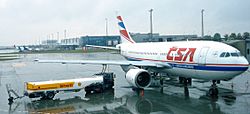Jet fuel facts for kids
Quick facts for kids Jet fuel |
|
|---|---|
 |
|
| Identifiers | |
| CAS number | |
| Properties | |
| Appearance | Straw-colored liquid |
| Density | 775.0-840.0 g/L |
| Melting point |
-47 °C, 226 K, -53 °F |
| Boiling point |
176 °C, 449 K, 349 °F |
| Hazards | |
| NFPA 704 |
|
| Except where noted otherwise, data are given for materials in their standard state (at 25 °C, 100 kPa) | |
Jet fuel, aviation turbine fuel (ATF), or avtur, is a type of aviation fuel designed for use in aircraft powered by gas-turbine engines. It is colorless to straw-colored in appearance. The most commonly used fuels for commercial aviation are Jet A and Jet A-1, which are produced to a standardized international specification. The only other jet fuel commonly used in civilian turbine-engine powered aviation is Jet B, which is used for its enhanced cold-weather performance.
Jet fuel is a mixture of a large number of different hydrocarbons. The range of their sizes (molecular weights or carbon numbers) is defined by the requirements for the product, such as the freezing or smoke point.
Standards
Most jet fuels in use since the end of World War II are kerosene-based. Both British and American standards for jet fuels were first established at the end of World War II. British standards derived from standards for kerosene use for lamps—known as paraffin in the UK—whereas American standards derived from aviation gasoline practices. Over the subsequent years, details of specifications were adjusted, such as minimum freezing point, to balance performance requirements and availability of fuels.
Worldwide consumption of jet fuel
Worldwide demand of jet fuel has been steadily increasing since 1980. Consumption more than tripled in 30 years from 1,837,000 barrels/day in 1980, to 5,220,000 in 2010. Around 30% of the worldwide consumption of jet fuel is in the US (1,398,130 barrels/day in 2012).
Images for kids
-
Shell Jet A-1 refueller truck on the ramp at Vancouver International Airport. Note the signs indicating UN1863 hazardous material and JET A-1.
-
A US Airways Boeing 757 being fueled at Fort Lauderdale–Hollywood International Airport
-
An Iberia Airbus A340 being fueled at La Aurora International Airport
See also
 In Spanish: Combustible de turbina de aviación para niños
In Spanish: Combustible de turbina de aviación para niños






